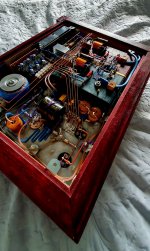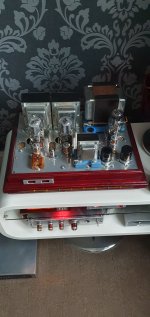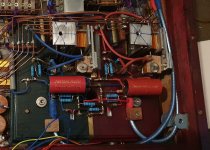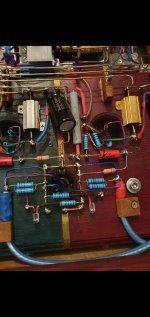That's very kind thank you.That's how we all started. Just keep on learning!
I've had the amp running great for 2 years and after one of the KT88's 'ran-away' causing the cathode resistor to burn out, I changed to KT66. Just this gremlin to try to get to the bottom off.
Attachments
Could it be possible that the input tube has failed? Or the LED,'s? It seems odd that the problem is with both channels. There's not much else that can go wrong, the plate connection, led bias and earth connection.
OK so,
I've taken all valves out (as the voltage rises too fast it won't give me time to check) and have undertaken some basic grounding checks.
Measuring, first, the KT66's at pin 8 and the DMM's black probe all the way back to star earth point.
Right Channel - 561R
Left Channel - 556R
Measuring 6n1p at pin 3 and 8 with the DMM's black probe all the way back to star earth point.
Right Channel (pin 3) - 8.76R
Left Channel (pin 8) - 8.78R
It looks like all valves are grounded OK (?)
I've taken all valves out (as the voltage rises too fast it won't give me time to check) and have undertaken some basic grounding checks.
Measuring, first, the KT66's at pin 8 and the DMM's black probe all the way back to star earth point.
Right Channel - 561R
Left Channel - 556R
Measuring 6n1p at pin 3 and 8 with the DMM's black probe all the way back to star earth point.
Right Channel (pin 3) - 8.76R
Left Channel (pin 8) - 8.78R
It looks like all valves are grounded OK (?)
Definitely going up, and up and up, too scared to leave them on longer, it's as if it will not stop. Quickly too.yes, make sure your grounding scheme is complete. b+ should go down as tubes begin conducting.
The tubes appear to be grounded as my previous post.
If you take out the tubes you have a guarantee that B+ will go up to the max.
Your elcaps won't like that.
What's the transformer secondary AC voltage? If you multiply that with 1.4, does that give you the very high B+?
Jan
Your elcaps won't like that.
What's the transformer secondary AC voltage? If you multiply that with 1.4, does that give you the very high B+?
Jan
Its OK, I didn't power the amp on without the tubes I took them out just to do some basic grounding checks unpowered. Results as post above.
The problem is even with the tubes in, B+ still shoots up. So I can't really measure anything with the amp on as I feel the caps will blow.
The tubes measure as they are grounded but with B+ still rising and rising it's apparent that they are not conducting.
Mains TX is 750v centre tapped, so unloaded should be around 525v. I think I got to 510v then switched off.
The problem is even with the tubes in, B+ still shoots up. So I can't really measure anything with the amp on as I feel the caps will blow.
The tubes measure as they are grounded but with B+ still rising and rising it's apparent that they are not conducting.
Mains TX is 750v centre tapped, so unloaded should be around 525v. I think I got to 510v then switched off.
That's interestiung. Your measurements indicate about 72mA per output tube, that's 144 mA for two (assuming one supply for both tubes).
So if the transformer is specified for 2 x 350V @ 180mA as shown in your schematic, it won't drop under load.
Is there a tap on the primary to strap for higher mains?
Jan
So if the transformer is specified for 2 x 350V @ 180mA as shown in your schematic, it won't drop under load.
Is there a tap on the primary to strap for higher mains?
Jan
Hang on. B+ rises during power-up. Before the power tubes' filaments are hot, they can't conduct, and your transformer will create a higher than expected voltage. As the power tubes begin to conduct, the B+ will come down, and settle. As an example, my latest lil kit EL84 amp goes up to 390v before settling around 330v after ~15 seconds.
Are you seeing the rise in b+ during those first 15 seconds after flipping the switch? Normal. Your caps do need to be rated for that voltage. Interestingly, F&T caps' datasheet list a higher voltage that can be tolerated for a short time period ie a 500v cap can do 550v for 10 seconds. Check.your datasheet, replace what you must.
Are you seeing the rise in b+ during those first 15 seconds after flipping the switch? Normal. Your caps do need to be rated for that voltage. Interestingly, F&T caps' datasheet list a higher voltage that can be tolerated for a short time period ie a 500v cap can do 550v for 10 seconds. Check.your datasheet, replace what you must.
I have little diagram of the Mains Tx as attached.
Just a few pointers.
I have voltage to the plates, connections to ground and heat? Only thing left is connection to the output transformer?
Yes, that could be correct, but mine keeps rising very quickly. I don't think I dare leave it on. The plate voltage with KT88's were 425v and I'm turning the amp off at around 510v with the KT66's. I think it was still rising and showing no signs of slowing down. When I switch off, the voltage drops dramatically on the cathodes and reduces slowly on B+ at the 4.7k resistor.Hang on. B+ rises during power-up. Before the power tubes' filaments are hot, they can't conduct, and your transformer will create a higher than expected voltage. As the power tubes begin to conduct, the B+ will come down, and settle. As an example, my latest lil kit EL84 amp goes up to 390v before settling around 330v after ~15 seconds.
Are you seeing the rise in b+ during those first 15 seconds after flipping the switch? Normal. Your caps do need to be rated for that voltage. Interestingly, F&T caps' datasheet list a higher voltage that can be tolerated for a short time period ie a 500v cap can do 550v for 10 seconds. Check.your datasheet, replace what you must.
Just a few pointers.
- the tubes all measure as if they are grounded OK.
- there is no voltage drop across 4.7k resistor (I don't understand why this would be, it is a series resistor how can it not drop voltage?)
- after only a few seconds of switch on, all the tubes are warm to the touch, indicating that the heaters are OK.
- as B+ increases, a notable hum starts through the speakers (up to now this has been my switch off warning).
I have voltage to the plates, connections to ground and heat? Only thing left is connection to the output transformer?
Last edited:
max plate voltage is Plate To Cathode not Plate to Ground. Your cathode is 40v, don't forget to subtract that from your plate voltage. you're still safe.
That's reassuring but using Rob Robinettes calculator that makes the KT66 over 100% plate dissapation.max plate voltage is Plate To Cathode not Plate to Ground. Your cathode is 40v, don't forget to subtract that from your plate voltage. you're still safe.
Would there be such a drastic increase in voltage between the two valves? (KT88 v KT66). I would have thought B+ would be the same, but cathode voltage would be different?
I do recall measuring the amp 2 yrs ago when first built, that was stable almost straight away.
Sorry to keep asking BTW just want to try to cover all possibilities as I'm really weary about leaving the amp on.
The power transformer creates power in watts, or Volt Amps. A transformer will make the rated voltage when the rated amount of amps are drawn. If fewer amps are drawn, the voltage will go up, to a point known as Zero Load Voltage. Ok. So when you put in a tube that draws less current (KT66) the PT will make a higher voltage to keep the output constant. You might be obligated to use KT88 to keep your circuit happy.
No voltage drop in an element of your power supply (4k7 resistor) means current is not flowing in that leg of the circuit. Maybe the 33uF cap is bad, maybe the tube is bad, maybe the LED is dead, or backwards, maybe that resistor is blown. Something is blocking the flow of current.
No voltage drop in an element of your power supply (4k7 resistor) means current is not flowing in that leg of the circuit. Maybe the 33uF cap is bad, maybe the tube is bad, maybe the LED is dead, or backwards, maybe that resistor is blown. Something is blocking the flow of current.
KT66 Plate Dissipation 25 Watts; Screen 3.5 Watts. You can not have them both at Maximum at the same time; P+S Only = 27 Watts *; Not 28.5 Watts.
For Cathode Bias (Self Bias):
Wth control grid resistor at 1M Ohm maximum, P+S maximum is 27 Watts.
Wth control grid resistor at 500k maximum, P+S maximum is > 27 Watts (> conflicts with the above 27 Watts * max, no matter what Rg is).
KT88
Plate Dissipation 42 Watts; Screen 8 Watts. You can not have them both at Maximum at the same time; P+S Only = 46 Watts, Not 50 Watts.
Your Tube Data Sheets May Vary.
For Cathode Bias (Self Bias):
Wth control grid resistor at 1M Ohm maximum, P+S maximum is 27 Watts.
Wth control grid resistor at 500k maximum, P+S maximum is > 27 Watts (> conflicts with the above 27 Watts * max, no matter what Rg is).
KT88
Plate Dissipation 42 Watts; Screen 8 Watts. You can not have them both at Maximum at the same time; P+S Only = 46 Watts, Not 50 Watts.
Your Tube Data Sheets May Vary.
Last edited:
This is my thinking too, it must be the cap or LED.Maybe the 33uF cap is bad, maybe the tube is bad, maybe the LED is dead, or backwards, maybe that resistor is blown. Something is blocking the flow of current.
The reason I changed from KT88 to KT66 is that for two years everything was running OK with the KT88's. Then, one of tubes went into voltage 'runaway' and burnt out the cathode resistor (picture attached, one on the left, silver not gold). In my, lack of wisdom, I mounted them on plywood and not the chassis (!).
So, maybe damage occured elsewhere?
I am going to start with replacing the LED and resistor, then the cap, we'll see what happens.
Also, I did think about the KT88's too. I'd like to keep the KT66's at half the price, again, we'll see.
Attachments
Ya I'd replace any parts that were involved in a catastrophic failure. Think how much voltage the PT made when the tube stopped conducting, a big spike could have damaged the caps.
You should also think about a dropping resistor in the power supply, maybe a 200-350 ohm 5-10w wirewound resistor between the rectifier and the choke. Bring down that b+ a bit. And KT66 might prefer the 560-ohm cathode resistor.
You should also think about a dropping resistor in the power supply, maybe a 200-350 ohm 5-10w wirewound resistor between the rectifier and the choke. Bring down that b+ a bit. And KT66 might prefer the 560-ohm cathode resistor.
Last edited:
- Home
- Amplifiers
- Tubes / Valves
- KT88SE - with EL34s



